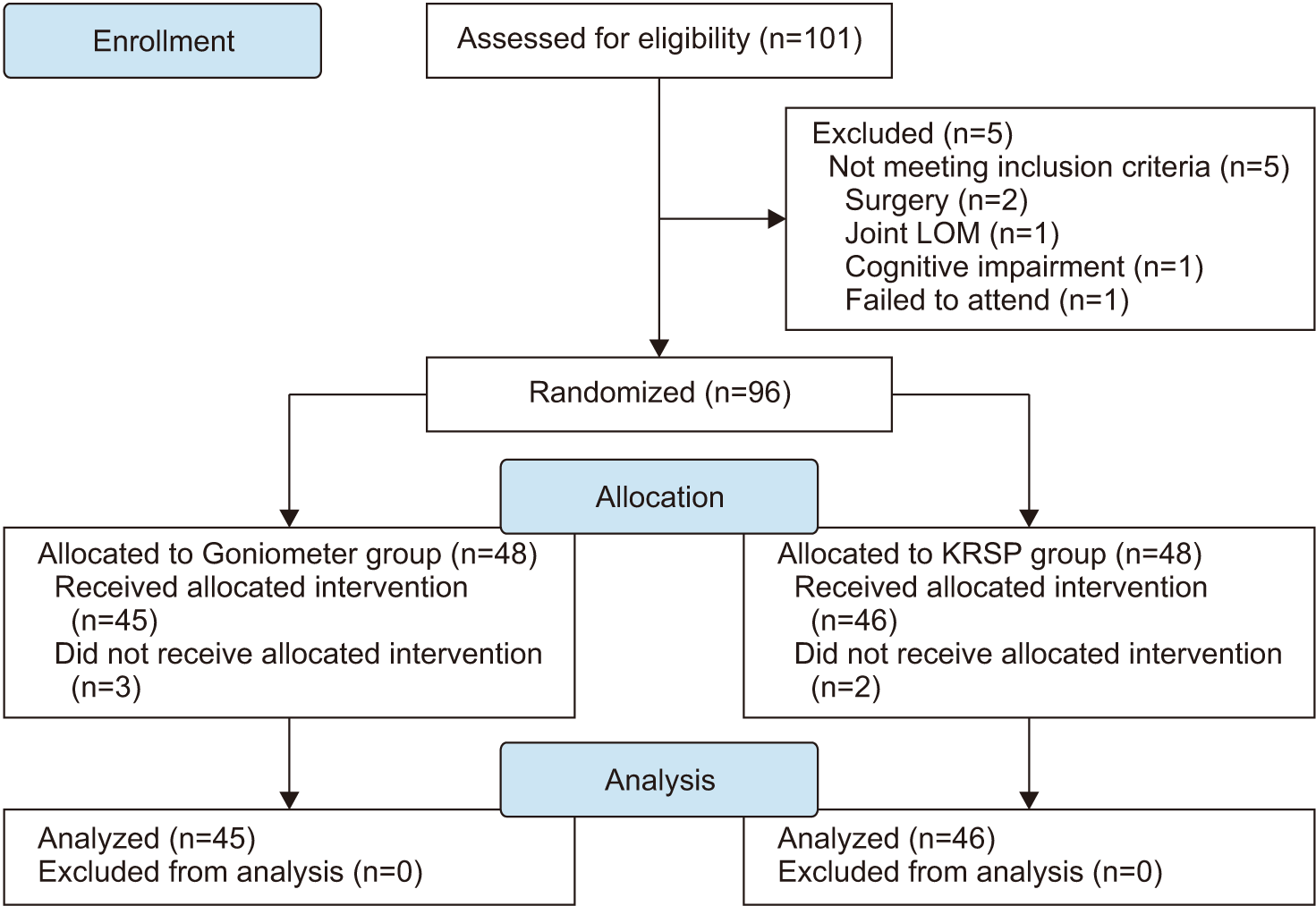1. Fleiss JL, Cohen J. The equivalence of weighted kappa and the intraclass correlation coefficient as measures of reliability. Educ Psychol Meas. 1973; 33:613–9.

2. Cocchiarella L, Andersson GB. Guides to the evaluation of permanent impairment. 5th ed. Chicago: American Medical Association;2000. p. 433–455.
3. Rondinelli R. Guides to the evaluation of permanent impairment. 6th ed. Chicago: American Medical Association;2007.
4. American Medical Association. AMA Guides to the evaluation of permanent impairment. 4th ed. Chicago: American Medical Association;1993.
5. American Medical Association. Guides to the evaluation of permanent impairment. 3rd ed. Chicago: American Medical Association;1990.
6. McBride ED. Disability evaluation and principles of treatment of compensable injuries. Philadelphia: J. B. Lippincott;1963.
7. Cho KH, Jeon Y, Lee H. Range of motion of the ankle according to pushing force, gender and knee position. Ann Rehabil Med. 2016; 40:271–8.

8. Laupattarakasem W, Sirichativapee W, Kowsuwon W, Sribunditkul S, Suibnugarn C. Axial rotation gravity goniometer. A simple design of instrument and a controlled reliability study. Clin Orthop Relat Res. 1990; (251):271–4.

9. Gajdosik RL, Bohannon RW. Clinical measurement of range of motion. Review of goniometry emphasizing reliability and validity. Phys Ther. 1987; 67:1867–72.
10. Kolber MJ, Fuller C, Marshall J, Wright A, Hanney WJ. The reliability and concurrent validity of scapular plane shoulder elevation measurements using a digital inclinometer and goniometer. Physiother Theory Pract. 2012; 28:161–8.

11. van Trijffel E, van de Pol RJ, Oostendorp RA, Lucas C. Inter-rater reliability for measurement of passive physiological movements in lower extremity joints is generally low: a systematic review. J Physiother. 2010; 56:223–35.

12. Park W, Ramachandran J, Weisman P, Jung ES. Obesity effect on male active joint range of motion. Ergonomics. 2010; 53:102–8.

13. Herda L, Fua P, Plankers R, Boulic R, Thalmann D. Using skeleton-based tracking to increase the reliability of optical motion capture. Hum Mov Sci. 2001; 20:313–41.

14. Perez R, Costa U, Torrent M, Solana J, Opisso E, Caceres C, et al. Upper limb portable motion analysis system based on inertial technology for neurorehabilitation purposes. Sensors (Basel). 2010; 10:10733–51.
15. El-Zayat BF, Efe T, Heidrich A, Anetsmann R, Timmesfeld N, Fuchs-Winkelmann S, et al. Objective assessment, repeatability, and agreement of shoulder ROM with a 3D gyroscope. BMC Musculoskelet Disord. 2013; 14:72.

16. Bonnechere B, Jansen B, Salvia P, Bouzahouene H, Omelina L, Moiseev F, et al. Validity and reliability of the Kinect within functional assessment activities: comparison with standard stereophotogrammetry. Gait Posture. 2014; 39:593–8.
17. Lee SH, Yoon C, Chung SG, Kim HC, Kwak Y, Park HW, et al. Measurement of shoulder range of motion in patients with adhesive capsulitis using a kinect. PLoS One. 2015; 10:e0129398.

18. Werner BC, Holzgrefe RE, Griffin JW, Lyons ML, Cosgrove CT, Hart JM, et al. Validation of an innovative method of shoulder range-of-motion measurement using a smartphone clinometer application. J Shoulder Elbow Surg. 2014; 23:e275–82.

19. Shin SH, Ro du H, Lee OS, Oh JH, Kim SH. Within-day reliability of shoulder range of motion measurement with a smartphone. Man Ther. 2012; 17:298–304.

20. Jenny JY. Measurement of the knee flexion angle with a Smartphone-application is precise and accurate. J Arthroplasty. 2013; 28:784–7.

21. Milanese S, Gordon S, Buettner P, Flavell C, Ruston S, Coe D, et al. Reliability and concurrent validity of knee angle measurement: smart phone app versus universal goniometer used by experienced and novice clinicians. Man Ther. 2014; 19:569–74.

22. Vohralik SL, Bowen AR, Burns J, Hiller CE, Nightingale EJ. Reliability and validity of a smartphone app to measure joint range. Am J Phys Med Rehabil. 2015; 94:325–30.

23. Hoving JL, Buchbinder R, Green S, Forbes A, Bellamy N, Brand C, et al. How reliably do rheumatologists measure shoulder movement? Ann Rheum Dis. 2002; 61:612–6.

24. de Winter AF, Heemskerk MA, Terwee CB, Jans MP, Deville W, van Schaardenburg DJ, et al. Inter-observer reproducibility of measurements of range of motion in patients with shoulder pain using a digital inclinometer. BMC Musculoskelet Disord. 2004; 5:18.

25. Hayes K, Walton JR, Szomor ZR, Murrell GA. Reliability of five methods for assessing shoulder range of motion. Aust J Physiother. 2001; 47:289–94.

26. Rothstein JM, Miller PJ, Roettger RF. Goniometric reliability in a clinical setting. Elbow and knee measurements. Phys Ther. 1983; 63:1611–5.

27. Watkins MA, Riddle DL, Lamb RL, Personius WJ. Reliability of goniometric measurements and visual estimates of knee range of motion obtained in a clinical setting. Phys Ther. 1991; 71:90–6.

28. Youdas JW, Bogard CL, Suman VJ. Reliability of goniometric measurements and visual estimates of ankle joint active range of motion obtained in a clinical setting. Arch Phys Med Rehabil. 1993; 74:1113–8.

29. LaStayo PC, Wheeler DL. Reliability of passive wrist flexion and extension goniometric measurements: a multicenter study. Phys Ther. 1994; 74:162–74.

30. Horger MM. The reliability of goniometric measurements of active and passive wrist motions. Am J Occup Ther. 1990; 44:342–8.

31. Armstrong AD, MacDermid JC, Chinchalkar S, Stevens RS, King GJ. Reliability of range-of-motion measurement in the elbow and forearm. J Shoulder Elbow Surg. 1998; 7:573–80.

32. Herrero P, Carrera P, Garcia E, Gomez-Trullen EM, Olivan-Blazquez B. Reliability of goniometric measurements in children with cerebral palsy: a comparative analysis of universal goniometer and electronic inclinometer. A pilot study. BMC Musculoskelet Disord. 2011; 12:155.

33. Poulsen E, Christensen HW, Penny JO, Overgaard S, Vach W, Hartvigsen J. Reproducibility of range of motion and muscle strength measurements in patients with hip osteoarthritis: an inter-rater study. BMC Musculoskelet Disord. 2012; 13:242.






 PDF
PDF Citation
Citation Print
Print



 XML Download
XML Download